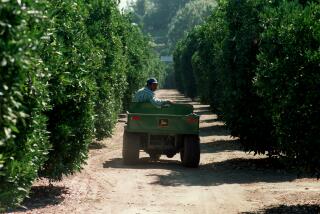L.A. Redux / The City Then and Now
In 1880, lush fields of yellow-orange poppies covered most of the foothill slopes of northern Pasadena. Considered a chaparral wasteland because it was too high to benefit from the Arroyo Seco, the city founders sold off 1,400 acres of the rolling hills. Two brothers, Fred and John Woodbury, bought 900 acres for $5 an acre, and a year later the remaining 500 acres were purchased by Peter J. Gano, Stanley P. Jewett and a few smaller investors. The men formed a syndicate in 1886 called the “Pasadena Improvement Co.”
Seeking a name for their land, the syndicate adopted the one Byron O. Clark gave to his 40-acre nursery on Lincoln Avenue--”Altadena,” the “higher Pasadena.” Clark spent most of his time landscaping the early estates, parks and streets in Pasadena. But after a heavy frost wiped out his entire stock before the turn of the century, Clark became discouraged and moved to Hawaii.
Another large parcel of land, which extended from Allen Avenue to Eaton Canyon, later became the northeast section of Altadena. It was purchased in 1878 by William Allen, a native of England who spent 23 years in Egypt. Allen paid $7.50 an acre for a 502-acre ranch he called “Sphinx Ranch.” About 45 years later, the property sold for $1,800 an acre.
The land purchases totaled about 8.8 square miles and was subdivided into 5- and 10-acre lots, attracting many Easterners seeking relief from cold winters. One was Col. George Green of New Jersey, who purchased 10 acres in the highlands for a winter home. He liked the area so much that he named his daughter Altadena. Green purchased the Webster Hotel in Pasadena, which he later changed to the Hotel Green.
The Los Angeles Electric Railway added a special car called “The Poppy” for people who wanted to travel in style from Los Angeles to the Pasadena area. The car was green like the others, but its name was spelled out on each side of the car in bunches of painted poppies.
An electric trolley excursion was also available from Santa Monica to Los Angeles, where passengers could transfer for a ride to Altadena. Just north of Calveras Street on Lake Avenue, the Mt. Lowe Railway began, stopping along the three-mile route to allow passengers to gather armfuls of poppies. It then headed north to the Rubio Station at Cabrillo Heights, where travelers could take the last mile of the inclined route to the famous “White City” hotel on the summit of Echo Mountain. A round-trip ticket cost $2, and for an additional fare of $3 travelers could continue 3 1/2 miles farther to Alpine Tavern.
Altadena now has has a population of 42,658, and homes cover the poppy fields that were said to be visible from decks of ships in the Catalina Channel.
More to Read
Sign up for Essential California
The most important California stories and recommendations in your inbox every morning.
You may occasionally receive promotional content from the Los Angeles Times.










